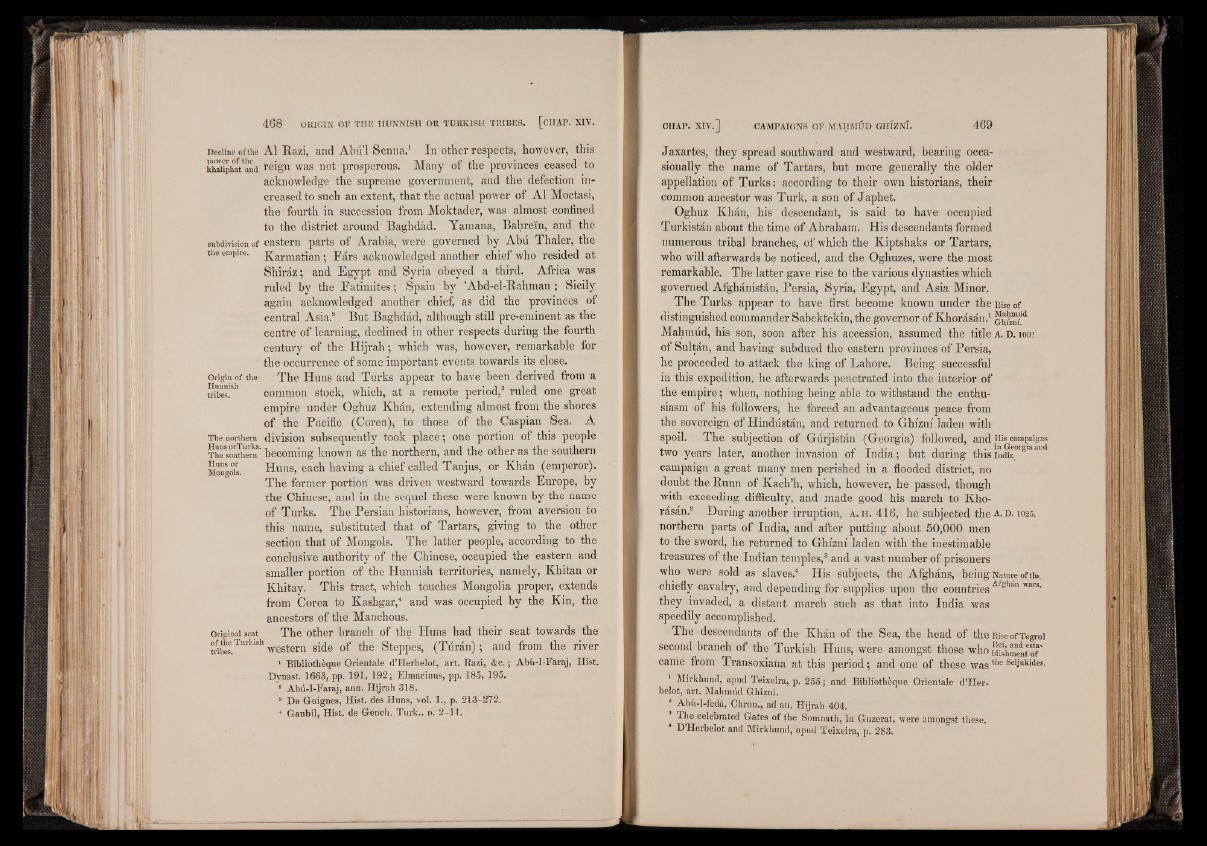
Decline of the A1 Eazi, and Abu 1 Senna.1 In other respects, however, this
khaiiphat^and reign was not prosperous. Many of the provinces ceased to
acknowledge the supreme government, and the defection increased
to such an extent, that the actual power of A1 Moctasi,
the fourth in succession from Moktader, was almost confined
to the district around Baghdad. Yamana, Bahreïn, and the
subdmsion of eastern parts of Arabia, were governed by Abu Thaler, the
the empire. Karmatian ; Fars acknowledged another chief who resided at
Shiraz ; and Egypt and Syria obeyed a third. Africa was
ruled by the Fatimites; Spain by ’Abd-el-Bahman ; Sicily
again acknowledged another chief, as did the provinces of
central Asia.2 But Baghdad, although still pre-eminent as the
centre of learning, declined in other respects during the fourth
century of the Hijrah ; which was, however, remarkable for
the occurrence of some important events towards its close.
Origin of the The Huns and Turks appear to have been derived from a
tribïï.S common stock, which, at a remote period,3 ruled one great
empire under Oghuz Khan, extending almost from the shores
of the Pacific (Corea), to those of the Caspian Sea. A
The northern division subsequently took place ; one portion of this people
The^outhern ' becoming known as the northern, and the other as the southern
Mongols Huns, each having a chief called Tanjus, or Khan (emperor).
The former portion was driven westward towards Europe, by
the Chinese, and in the sequel these were known by the name
of Turks. The Persian historians, however, from aversion to
this name, substituted that of Tartars, giving to the other
section that of Mongols. The latter people, according to the
conclusive authority of the Chinese, occupied the eastern and
smaller portion of the Hunnish territories, namely, Khitan or
Khitay. This tract, which touches Mongolia proper, extends
from Corea to Kashgar,4 and was occupied by the Kin, the
ancestors of the Manchous.
original seat The other branch of the Huns had their seat towards the
mbes.Tark!Sh western side of the Steppes, (Turan) ; and from the river
1 Bibliothèque Orientale d’Herbelot, art. Razi, &c. ; Abû-1-Faraj, Hist.
Dynast. 1663, pp. 191, 192; Elmacinus, pp. 185, 195.
2 Abii-l-Faraj, ann. Hijrah 318.
3 De Guignes, Hist, des Huns, vol. I., p. 213-272.
4 Gaubil, Hist, de Gench. Turk., n. 2 -1 1.
Jaxartes, they spread southward and westward, bearing occasionally
the name of Tartars, but more generally the older
appellation of Turks: according to their own historians, their
common ancestor was Turk, a son of Japhet.
Oghuz Khán, his descendant, is said to have occupied
Turkistán about the time of Abraham. His descendants formed
numerous tribal branches, of which the Kiptshaks or Tartars,
who will afterwards be noticed, and the Oghuzes, were the most
remarkable. The latter gave rise to the various dynasties which
governed Afghánistán, Persia, Syria, Egypt, and Asia Minor.
The Turks appear to have first become known under the Rise of
distinguished commander Sabektekin, the governor of Khorásán.1
Mahmud, his son, soon after his accession, assumed the title a . d . io o i
of Sultán, and having subdued the eastern provinces of Persia,
he proceeded to attack the king of Lahore. Being successful
in this expedition, he afterwards penetrated into the interior of
the empire ; when, nothing being able to withstand the enthusiasm
of his followers, he forced an advantageous peace from
the sovereign of Hindústán, and returned to Ghizni laden with
spoil. The subjection of Gúrjistán (Georgia) followed, and His campaigns
two years later, another invasion of India; but during thisindk°rg'a'md
campaign a great many men perished in a flooded district, no
doubt the Bunn of Kach’h, which, however, he passed, though
with exceeding difficulty, and made good his march to Khorásán.
2 During another irruption, a . h . 4 1 6 , he subjected the a . d . 10 2 5 .
northern parts of India, and after putting about 50,000 men
to the sword, he returned to Ghizni laden with the inestimable
treasures of the Indian temples,3 and a vast number of prisoners
who were sold as slaves.4 His subjects, the Afgháns, being Nature of tK
chiefly cavalry, and depending for supplies upon the countries Afehan wars-
they invaded, a distant march such as that into India was
speedily accomplished.
The descendants of the Khán of the Sea, the head of the RiseofTogrui
second branch of the Turkish Huns, were amongst those who biishment o f '
came from Transoxiana at this period ; and one of these wasthe Se,iukides-
Mirkhund, apud Teixeira, p. 255; and Bibliothèque Orientale d ’Iíe r-
belot, art. Mahmúd Ghizni.
2 Abú-1-fedá, Chron., ad an. Hijrah 404.
The celebrated Gates of the Somnáth, in Guzerat, were amongst these.
* D’Herbelot and Mirkhund, apud Teixeira, p. 283.